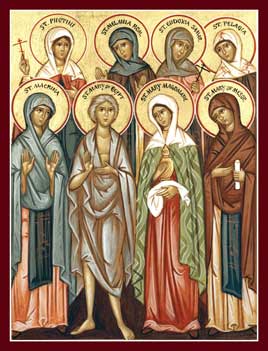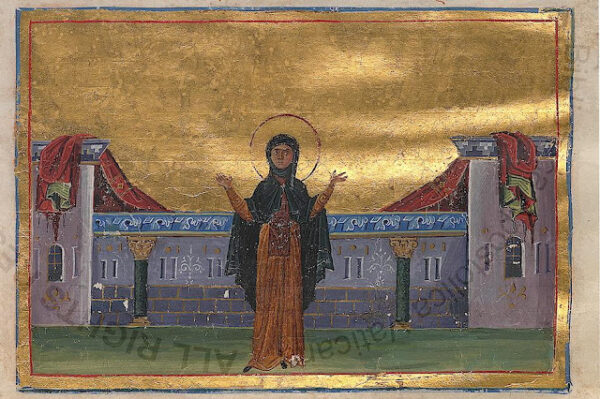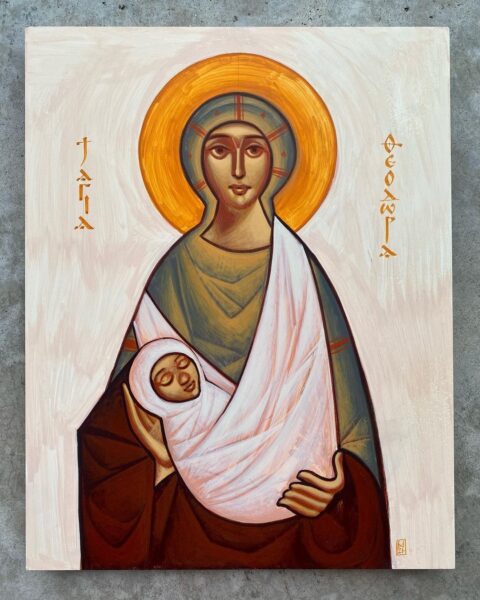 Last updated: December 8, 2023
Last updated: December 8, 2023
The Desert Mothers were women, known as ammas or “spiritual mothers,” who lived in the desert as Christian ascetics in the fourth and fifth centuries CE. Ammas were women who had achieved a spiritual maturity and wisdom that they developed during their withdrawal from mainstream society. These women gathered together in monastic communities, but there were also some who lived as hermits. For these early Christian women, one appeal of living in the desert was the freedom they could experience there that was not available to them in the usual female domains of the culture. As Christianity became more mainstream, women were attracted to the ascetic life. There they could participate in prophetic and monastic leadership, in spite of male church leaders who were uncomfortable with women in public roles.
The Desert Mothers were well known at the time and were often sought out as teachers and spiritual directors. Many lived in remote and hostile environments that enabled them to build up inner strength and to develop a life completely dependent on God alone. Amma Syncletica of Alexandria, Amma Theodora of Alexandria, and Amma Sarah of the Desert were the most prominent and best known ammas. Some of their sayings were included in Sayings of the Desert Fathers, a book of quotes, mainly from male abbas or “spiritual fathers,” that provides wisdom and insight into a desert spirituality. See references 1 and 2. Mary of Egypt, who lived as a desert ascetic in the fifth or sixth century CE, is also considered by some to be an example of a Desert Mother.
Theodora was the amma of a monastic community of women near Alexandria. It was said that she went to live in the desert disguised as a man, in order to join a community of monks. Not much is known about Amma Theodora from Western sources, except that she reportedly provided counsel to Bishop Theophilus of Alexandria. Her feast day is celebrated on September 11.
 However, the legend about her from Eastern Orthodox sources provides another possibility. See reference 6. According to the story, Theodora committed adultery against her husband and, in remorse, dressed as a man to go in penance to live in the desert. She went to a male monastery because she thought her husband would find her if she went to a female monastery. She spent eight years there, and then one day was sent into Alexandria to buy supplies. As she was delayed, Theodora stayed overnight at the Enata monastery. The daughter of the igumen (monastic leader) there tried to seduce Theodora, thinking that she was a man and was refused. So the daughter then became pregnant by another guest at Enata and when it became obvious, she said that Theodora was the father. Once the baby arrived, the child was delivered to Theodora’s monastery, where Theodora denied the accusation. Nevertheless, she was not believed and was banished, thrown with the baby out of the monastic enclosure. Theodora and the baby settled into a nearby hut and lived there in severe poverty for seven years. Eventually the monks were able to convince their igumen, who experienced a
However, the legend about her from Eastern Orthodox sources provides another possibility. See reference 6. According to the story, Theodora committed adultery against her husband and, in remorse, dressed as a man to go in penance to live in the desert. She went to a male monastery because she thought her husband would find her if she went to a female monastery. She spent eight years there, and then one day was sent into Alexandria to buy supplies. As she was delayed, Theodora stayed overnight at the Enata monastery. The daughter of the igumen (monastic leader) there tried to seduce Theodora, thinking that she was a man and was refused. So the daughter then became pregnant by another guest at Enata and when it became obvious, she said that Theodora was the father. Once the baby arrived, the child was delivered to Theodora’s monastery, where Theodora denied the accusation. Nevertheless, she was not believed and was banished, thrown with the baby out of the monastic enclosure. Theodora and the baby settled into a nearby hut and lived there in severe poverty for seven years. Eventually the monks were able to convince their igumen, who experienced a  revelation from God that the sin was forgiven, to readmit Theodora and the boy. Theodora performed miracles and was held in great esteem by the monks. After she died, the community found out that she was a woman and they asked her for forgiveness. Theodora’s husband heard about it and entered the monastery, along with Theodora’s boy who eventually became igumen of the monastery himself.
revelation from God that the sin was forgiven, to readmit Theodora and the boy. Theodora performed miracles and was held in great esteem by the monks. After she died, the community found out that she was a woman and they asked her for forgiveness. Theodora’s husband heard about it and entered the monastery, along with Theodora’s boy who eventually became igumen of the monastery himself.
Here is the quote from Amma Theodora that I have chosen to include in my book and the acrylic monoprint that I made to go with it.
Let us strive to enter by the narrow gate. Just as the trees, if they have not stood before the winter’s storms cannot bear fruit, so it is with us; this present age is a storm and it is only through many trials and temptations that we can obtain an inheritance in the kingdom of heaven.
Amma Theodora (fourth century CE)
 Ammas lived in close contact with nature and would have understood that a “winter’s storm” does not indicate an absence of God, but rather is a necessary part of the natural cycle of life and the turning of the seasons. And as she writes that “this present age is a storm,” it seems to me to be just as true in the twenty-first century as it was in the fourth.
Ammas lived in close contact with nature and would have understood that a “winter’s storm” does not indicate an absence of God, but rather is a necessary part of the natural cycle of life and the turning of the seasons. And as she writes that “this present age is a storm,” it seems to me to be just as true in the twenty-first century as it was in the fourth.
UPDATES: This blog post was updated on June 7, 2023 to include more references, two images of Amma Theodora, and additional information related to ammas and their spiritual practices. On August 15, 2023, it was further updated to include the Eastern Orthodox legend of Saint Theodora and to add another image of Amma Theodora. On December 8, 2023 this blog post was updated to include Reference 5.
Reference 1: Swan, Laura, “The Forgotten Desert Mothers: Sayings, Liv es, and Stories of Early Christian Women,” Paulist Press, Mahwah, NJ, 2001.
Reference 2: Ward, Benedicta, “The Sayings of the Desert Fathers,” Cistercian Publications, Kalamazoo, MI, 1984.
Reference 3: Earle, Mary, “The Desert Mothers: Spiritual Practices from the Women of the Wilderness,” Morehouse Publishing, Harrisburg, NY, 2007.
Reference 4: Forman, Mary, “Praying with the Desert Mothers, Liturgical Press, Collegeville, MN, 2005.
Reference 5: Chittister, Joan, “In God’s Holy Light: Wisdom from the Desert Monastics,” Franciscan Media, Cincinnati OH, 2015.
 Reference 6: Venarable Theodora of Alexandria, blog post, Orthodox Church in America, https://www.oca.org/saints/lives/2017/09/11/102570-venerable-theodora-of-alexandria, 2017.
Reference 6: Venarable Theodora of Alexandria, blog post, Orthodox Church in America, https://www.oca.org/saints/lives/2017/09/11/102570-venerable-theodora-of-alexandria, 2017.
Reference 7: Vivian, Tim, “Courageous Women: Three Desert Ammas – Theodora, Sarah, and Syncletica,” https://scholarworks.calstate.edu/downloads/g445cj508?locale=it, March 2020.
Image 1: “Eight Righteous Women,” icon written by unidentified monk at Holy Transfiguration Monastery, Brookline, MA.
Image 2: Miniature of Saint Theodora, illuminated manuscript Menologion of Basil II, circa 1000 CE, Vat. gr. 1613, Vatican Library, Rome.
Image 3: “The Narrow Gate,” Julie Henkener, 2017.
Image 4: Amma Theodora, copticicons on Instagram, November 20, 2021.
Image 5: Saint Theodora, Eastern Orthodox Icon, unknown artist, possibly in collection at Museo del Prado, Madrid, Spain.















Leave a Reply
Join the conversation by submitting a comment to this blog post below.